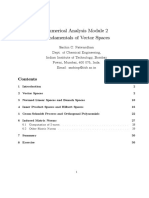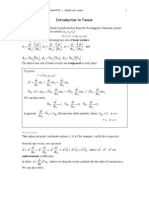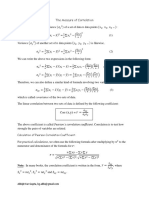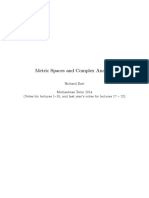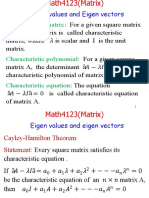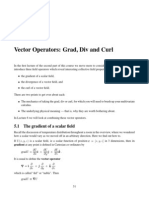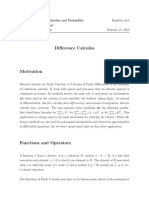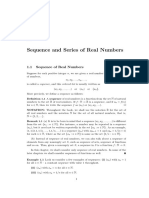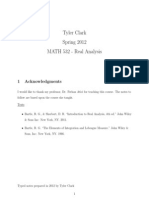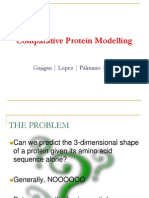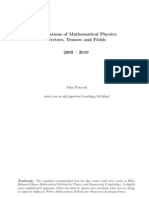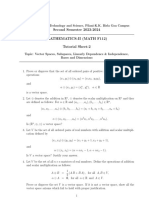Lecture - I Vector Space
Lecture - I Vector Space
Uploaded by
Abhijit Kar GuptaCopyright:
Available Formats
Lecture - I Vector Space
Lecture - I Vector Space
Uploaded by
Abhijit Kar GuptaCopyright
Available Formats
Share this document
Did you find this document useful?
Is this content inappropriate?
Copyright:
Available Formats
Lecture - I Vector Space
Lecture - I Vector Space
Uploaded by
Abhijit Kar GuptaCopyright:
Available Formats
Lecture Notes compiled by Dr. Abhijit Kar Gupta, kg.abhi@gmail.
com
Introduction to Vector Space
Basic Concept:
A vector has components. Example: Position vector, ( A scalar has no components. Example: Mass,
Components of a vector are scalars; the scalars are some numbers that can be real or complex. Real numbers are drawn from a real field and the complex numbers are drawn from a complex field . Therefore, a vector is always defined over a field. The number of components (or tuples) of a vector corresponds to the dimension of the space, we define it later as vector space! In the beginning, as we wrote the components ( ), they are all real, so they belong to the real field. We write, . To construct a vector space, there are some axioms that have to be followed, that we describe later.
Why the study of Vector Space?
Many mathematical systems satisfy the vector space axioms. The set of all complex numbers and suitable sets of vectors, matrices, polynomials, functions all satisfy the structure of vector space. We should therefore, study the properties of the abstract vector space. in general. Then we can apply them to more specific mathematical systems representing specific physical problems. Examples from Physics: Fourier components, Special functions etc.
What is Field?
A field is a set in which all the mathematical operations like addition, subtraction, multiplication and division are well defined among its members. Example: The set of rational numbers , the set of real numbers numbers . Note: The set of integer numbers is not a field. In general, we denote a field by the symbol . A field can be infinite or finite accordingly as its members.
To define a Field:
, the set of complex
A field is a non-empty set on which two operations, addition (+) and multiplication (.) are defined such that the following axioms hold for all members
.
1
Lecture Notes compiled by Dr. Abhijit Kar Gupta, kg.abhi@gmail.com
Addition: i. ii. iii. iv. v.
(closure property)
(Commutativity) ( ) ( ) (associativity) There exists 0 such that (identity) ( ) There exists an element so that
(inverse)
Multiplication: i. ii. iii. iv. v.
(closure property)
(Commutativity) ( ) ( ) (associativity) There exists 1 such that If , there exists an element (identity) such that
(inverse)
Next we define a Vector Space in terms of axioms. Vector Space: A non-empty set V is said to be a vector space over a field if for all the following axioms hold. Addition: i. ii. iii. iv. v. V (closure) (Commutativity) ( ) ( ) (associativity) There exists an element V, such that ( There exists an element V so that V and
(identity) (inverse)
Scalar Multiplication: i. ii. iii. iv. v. ( ( ( V (closure) ) (distributive over vector addition) ) (distributive over scalar addition) ) ( ) (associativity) (identity) is a vector space over the real field . Consider the vectors, ( . ) and so
Example:
on. Similarly, is a vector space over the complex field of dimension
Lecture Notes compiled by Dr. Abhijit Kar Gupta, kg.abhi@gmail.com
NOTE: In general,
is a vector space over the field where the vectors are n-tuples and the *(( )
elements are drawn from the field . We symbolically write,
+ .
Any set that is isomorphic to the vector space is also a vector space (with the operations defined).
What is isomorphism?
If there is a linear mapping, such that the two vector spaces we call them isomorphic. The mapping is then called isomorphism.
and
are one to one,
Note that isomorphism is invertible. This is a more precise way of saying equivalent.
When is a mapping linear?
The mapping is linear if it preserves the two basic operations of a vector space: vector addition and scalar multiplication such that the following laws hold. (i) (ii) V ( , V ( ) ) ( ) ( ) ( ) [Think as an operator.]
[We may study the mapping, its properties, in general and then there are the concepts of Image and kernel, we may look up any text book for definitions.]
Some Examples of Vector Space
# MATRICES: A matrix over a field , ( ), and each column as a vector
Each row in the above can be regarded as a vector ( -tuples) in ( -tuples) in .
Any operation defined for the vector space cane be applied to every row of the matrix . Similarly, any operation defined for the vector space can also be applied to every column of ) tuple of the matrix . Thus the rows and columns of cane be joined to give a ( elements in . Therefore, the set of all ( to . ) matrices over is a vector space isomorphic
Lecture Notes compiled by Dr. Abhijit Kar Gupta, kg.abhi@gmail.com
The operations of addition and scalar multiplication: ( ( Where (rows), ) ) , (columns), . is
Note: The vector space is isomorphic to the vector space if row vectors and isomorphic to vector space of column vectors. We can similarly construct the vector spaces with functions or polynomials etc. (More discussions on this, later.)
On Linear Dependence of Vectors
Linear combination: Let are elements of a vector space V over a field . A linear combination of the elements will be another element of V and is expressed as , where ,
Linear dependence: If the linear combination of the vectors, , and the coefficients ( ), at least one of them, is nonzero then the vectors are called linearly dependent. For example, for two vectors, , one is -times the other, . + in the vector space V over a field Linear Independence: The set of vectors * is linearly independent if and only if the solution of the following equation yields .
Examples: #1. Is the set of vectors {(1,1), (1,-1)} Ans. ( ) ( ) linearly independent? and
, So the vectors are linearly independent.
#2. The following set of vectors {(1, 0, 0), (0, 1, 0), (0, 0, 1)}
is linearly independent. Why?
4
Lecture Notes compiled by Dr. Abhijit Kar Gupta, kg.abhi@gmail.com
Ans.
))
#3. How is about the following set of vectors {(1,1), (-1,-1)} Ans. ( ) ( )
, are they linearly dependent?
Here we find two solutions, However, if we consider vectors are linearly dependent.
and which implies no unique solution. , that can satisfy the above. Thus we can say, the
Books to Consult: 1. 2. 3. 4. 5. 6. 7. Linear Algebra Seymour Lipschutz (Schaums Outline Series) Linear Algebra - K. Hoffman, Ray Kunze (Prentice Hall) Linear Algebra Francis J. Wright (Lecture Notes) [centaur.maths.qmw.ac.uk] Linear Algebra and Matrices Martin Fluch (Deptt. of Maths, Univ. of Helsinki webpage) Linear Algebra Paul Dawkins (Lecture Notes in www.scribd.com) Berkley Lecture Notes Edward Carter Linear Algebra V.V. Voyevodin (Mir Pub, Moscow)
You might also like
- Numerical Analysis Module 2 Fundamentals of Vector SpacesDocument33 pagesNumerical Analysis Module 2 Fundamentals of Vector Spacespartha4uNo ratings yet
- Einstein-Hilbert ActionDocument5 pagesEinstein-Hilbert Actionrr1819No ratings yet
- Matrix AssignmentDocument10 pagesMatrix AssignmentNawshad HasanNo ratings yet
- Set TheoryDocument37 pagesSet TheoryNilgün IlgıcıoğluNo ratings yet
- Statistical Mechanics TEST QuestionsDocument2 pagesStatistical Mechanics TEST QuestionsAbhijit Kar Gupta81% (43)
- Vector SpaceDocument42 pagesVector SpaceRahuldeb DasNo ratings yet
- Lectures On Classical Mechanics1 PDFDocument3 pagesLectures On Classical Mechanics1 PDFehsanyari1100% (1)
- Introduction To TensorDocument6 pagesIntroduction To TensorAbhijit Kar Gupta100% (2)
- CorrelationDocument11 pagesCorrelationAbhijit Kar GuptaNo ratings yet
- Linear AlgebraDocument72 pagesLinear AlgebraPaawanDubalNo ratings yet
- Metric Spaces and Complex AnalysisDocument120 pagesMetric Spaces and Complex AnalysisMayank KumarNo ratings yet
- Lectures On Classical Mechanics-2Document2 pagesLectures On Classical Mechanics-2Abhijit Kar Gupta100% (1)
- Eigen Values and Eigen Vectors: Characteristic MatrixDocument12 pagesEigen Values and Eigen Vectors: Characteristic MatrixShadman Saqlain Rahman, 170021057100% (1)
- Pauls Online Notes - Differential Equations - Mechanical VibrationsDocument15 pagesPauls Online Notes - Differential Equations - Mechanical VibrationsRicardo ColosimoNo ratings yet
- Centroid SDocument50 pagesCentroid SAnu ParameswaranNo ratings yet
- Real Analysis ReviewDocument65 pagesReal Analysis ReviewLie ZelNo ratings yet
- Force of FrictionDocument30 pagesForce of FrictiongearnhaleNo ratings yet
- Subject: Analysis Iv Lesson: Connectedness in Metric Spaces by Dr. Satya GoelDocument23 pagesSubject: Analysis Iv Lesson: Connectedness in Metric Spaces by Dr. Satya GoelJeoff Libo-onNo ratings yet
- Probability and Geometry On Groups Lecture Notes For A Graduate CourseDocument209 pagesProbability and Geometry On Groups Lecture Notes For A Graduate CourseChristian Bazalar SalasNo ratings yet
- Computational ComplexityDocument7 pagesComputational ComplexityKBSNo ratings yet
- 18.1 Second-Order Euler EquationsDocument14 pages18.1 Second-Order Euler EquationsMunir AslamNo ratings yet
- C2T Unit-IiDocument18 pagesC2T Unit-IiTAPAS KUMAR JANANo ratings yet
- Vector Calculus - Understanding The GradientDocument6 pagesVector Calculus - Understanding The GradientMaaaranmaniNo ratings yet
- A Brief Introduction To Measure Theory and Integration. Bass, Richard F. 1998Document22 pagesA Brief Introduction To Measure Theory and Integration. Bass, Richard F. 1998José Daniel Rivera MedinaNo ratings yet
- Bernoulli's Inequality For Negative ExponentsDocument2 pagesBernoulli's Inequality For Negative Exponentsvic1234059No ratings yet
- Lectures On Classical Mechanics-1Document4 pagesLectures On Classical Mechanics-1Abhijit Kar Gupta100% (6)
- The Surreals Contain The PlumpDocument4 pagesThe Surreals Contain The PlumpVaclav VopravilNo ratings yet
- A Study of Fuzzy, Super Super Fuzzy Matrix TheoryDocument163 pagesA Study of Fuzzy, Super Super Fuzzy Matrix TheoryHemanth Kumar RajendakumarNo ratings yet
- Mathematics (Introduction To Linear Algebra)Document36 pagesMathematics (Introduction To Linear Algebra)shilpajosephNo ratings yet
- Proof of The Rearrangement InequalityDocument2 pagesProof of The Rearrangement Inequalitysahil ahmedNo ratings yet
- Sequences: Convergence and Divergence PDFDocument49 pagesSequences: Convergence and Divergence PDFstvo49100% (2)
- VectorsDocument27 pagesVectorsSuthara SudhakaranNo ratings yet
- Dynamical SystemsDocument102 pagesDynamical SystemsMirceaSuscaNo ratings yet
- Differential GeometryDocument161 pagesDifferential GeometrysajId146100% (1)
- SimplexDocument13 pagesSimplexarthur020306100% (1)
- Vector Operators: Grad, Div and Curl: 5.1 The Gradient of A Scalar FieldDocument21 pagesVector Operators: Grad, Div and Curl: 5.1 The Gradient of A Scalar FieldRajendra PrasathNo ratings yet
- The Euler Lagrange EquationsDocument8 pagesThe Euler Lagrange EquationsDimitrios TriantafyllidisNo ratings yet
- Project MphilDocument64 pagesProject Mphilrameshmaths_aplNo ratings yet
- Difference Calculus: N K 1 3 M X 1 N y 1 2 N K 0 KDocument9 pagesDifference Calculus: N K 1 3 M X 1 N y 1 2 N K 0 KAline GuedesNo ratings yet
- Ancient Methods of Calculating Square RootsDocument7 pagesAncient Methods of Calculating Square RootsNeutronNo ratings yet
- Ratio and Proportion Intro Lesson For GeometryDocument5 pagesRatio and Proportion Intro Lesson For Geometryezmoreldo100% (2)
- Sequence and Series of Real Numbers M.T. NairDocument38 pagesSequence and Series of Real Numbers M.T. NairVishal AnandNo ratings yet
- BartleDocument11 pagesBartleLucius Adonai67% (3)
- Protein ModellingDocument53 pagesProtein ModellingiluvgermieNo ratings yet
- Set Theory Lecture NotesDocument170 pagesSet Theory Lecture Notesyusuf100% (1)
- Mth-382 Analytical Dynamics: MSC MathematicsDocument51 pagesMth-382 Analytical Dynamics: MSC MathematicsediealiNo ratings yet
- Hyperbolic Functions - Sinh, Cosh, Tanh, Coth, Sech, CSCHDocument5 pagesHyperbolic Functions - Sinh, Cosh, Tanh, Coth, Sech, CSCHAnimasahun Olamide HammedNo ratings yet
- Measure Theory LiskevichDocument40 pagesMeasure Theory LiskevichDan GlinskiNo ratings yet
- DerangementsDocument1 pageDerangementsgauss202No ratings yet
- 08 Double Integrals in Polar Coordinates - HandoutDocument12 pages08 Double Integrals in Polar Coordinates - HandoutJelor GallegoNo ratings yet
- Applications of Derivatives Rate of Change (Calculus) Mathematics Question BankFrom EverandApplications of Derivatives Rate of Change (Calculus) Mathematics Question BankNo ratings yet
- Linear Algebra Review: CSC2515 - Machine Learning - Fall 2002Document7 pagesLinear Algebra Review: CSC2515 - Machine Learning - Fall 2002Pravin BhandarkarNo ratings yet
- Lect-VI Vector SpaceDocument11 pagesLect-VI Vector SpaceAbhijit Kar GuptaNo ratings yet
- Foundations of Mathematical Physics: Vectors, Tensors and Fields 2009 - 2010Document80 pagesFoundations of Mathematical Physics: Vectors, Tensors and Fields 2009 - 2010devkgunaNo ratings yet
- Linear Algebra I: Course No. 100 221 Fall 2006 Michael StollDocument68 pagesLinear Algebra I: Course No. 100 221 Fall 2006 Michael StollDilip Kumar100% (1)
- Linear AlgebraDocument296 pagesLinear Algebrarberio100% (1)
- Affine Transformation: Unlocking Visual Perspectives: Exploring Affine Transformation in Computer VisionFrom EverandAffine Transformation: Unlocking Visual Perspectives: Exploring Affine Transformation in Computer VisionNo ratings yet
- CorrelationDocument11 pagesCorrelationAbhijit Kar GuptaNo ratings yet
- Python 3 PDFDocument4 pagesPython 3 PDFAbhijit Kar Gupta100% (3)
- A Lecture On Teachers' DayDocument1 pageA Lecture On Teachers' DayAbhijit Kar Gupta100% (1)
- Tower of Hanoi: Fortran CodeDocument3 pagesTower of Hanoi: Fortran CodeAbhijit Kar GuptaNo ratings yet
- Covariance: A Little IntroductionDocument3 pagesCovariance: A Little IntroductionAbhijit Kar GuptaNo ratings yet
- Karnaugh Map (K-Map) and All ThatDocument5 pagesKarnaugh Map (K-Map) and All ThatAbhijit Kar GuptaNo ratings yet
- Path Analysis For Linear Multiple RegressionDocument3 pagesPath Analysis For Linear Multiple RegressionAbhijit Kar GuptaNo ratings yet
- Failure of Democracy in India?Document1 pageFailure of Democracy in India?Abhijit Kar GuptaNo ratings yet
- Solution To Question Paper IV, V.U. 2013Document9 pagesSolution To Question Paper IV, V.U. 2013Abhijit Kar GuptaNo ratings yet
- Lectures On Theoretical Mechanics - 7 (Rotating Coordinate System: Coriolis Force Etc.)Document6 pagesLectures On Theoretical Mechanics - 7 (Rotating Coordinate System: Coriolis Force Etc.)Abhijit Kar Gupta100% (1)
- Properties of Bulk MatterDocument1 pageProperties of Bulk MatterAbhijit Kar Gupta50% (2)
- Lect-VI Vector SpaceDocument11 pagesLect-VI Vector SpaceAbhijit Kar GuptaNo ratings yet
- How Can You Create A SUDOKU Puzzle?Document8 pagesHow Can You Create A SUDOKU Puzzle?Abhijit Kar GuptaNo ratings yet
- Quotes From LifeDocument3 pagesQuotes From LifeAbhijit Kar GuptaNo ratings yet
- Lect-V Vector SpaceDocument5 pagesLect-V Vector SpaceAbhijit Kar GuptaNo ratings yet
- Moments and Products of Inertia, Inertia TensorDocument4 pagesMoments and Products of Inertia, Inertia TensorAbhijit Kar Gupta100% (1)
- Lect-IV Vector SpaceDocument10 pagesLect-IV Vector SpaceAbhijit Kar GuptaNo ratings yet
- Lecture On Theoretical Mechanics - 4Document3 pagesLecture On Theoretical Mechanics - 4Abhijit Kar GuptaNo ratings yet
- Star-Delta TransformationDocument7 pagesStar-Delta TransformationAbhijit Kar Gupta80% (5)
- Stat Phys Lecture Notes For Undergrad StudentsDocument33 pagesStat Phys Lecture Notes For Undergrad StudentsAbhijit Kar Gupta100% (2)
- Measurement of Average Sky Glow by Digital CameraDocument6 pagesMeasurement of Average Sky Glow by Digital CameraAbhijit Kar GuptaNo ratings yet
- Radiometric Dating: Radioactive DecayDocument13 pagesRadiometric Dating: Radioactive DecayAbhijit Kar GuptaNo ratings yet
- Emcf 15 F14Document3 pagesEmcf 15 F14ShitPre SuperNo ratings yet
- Span of VectorsDocument8 pagesSpan of VectorsLuffy D. BrownsNo ratings yet
- Tutorial 2Document4 pagesTutorial 2Prinshu RawatNo ratings yet
- Nonlinear Programming 3rd Edition Theoretical Solutions ManualDocument26 pagesNonlinear Programming 3rd Edition Theoretical Solutions ManualJigo CasteloNo ratings yet
- Tutorial # 1 (Unit - I)Document9 pagesTutorial # 1 (Unit - I)pradnya RamgudeNo ratings yet
- ST_Module 4-2Document39 pagesST_Module 4-2Spoorthi SuvarnaNo ratings yet
- 01 Vector 3DDocument4 pages01 Vector 3DAniiNo ratings yet
- Population and Economic Growth in ASEAN EconomiesDocument18 pagesPopulation and Economic Growth in ASEAN EconomiesCBCP for LifeNo ratings yet
- Continuum Mechanics (George Backus) PDFDocument387 pagesContinuum Mechanics (George Backus) PDFWanderlei Malaquias Pereira JuniorNo ratings yet
- Algebra Course05Document5 pagesAlgebra Course05Pop RobertNo ratings yet
- Homework # 2 Solutions: Math 152, Fall 2014 Instructor: Dr. Doreen de LeonDocument3 pagesHomework # 2 Solutions: Math 152, Fall 2014 Instructor: Dr. Doreen de LeonHân BảoNo ratings yet
- Finite Element Method 2017 BatchDocument64 pagesFinite Element Method 2017 BatchSarah BardiNo ratings yet
- Linear Algebra Done Right Test 1Document7 pagesLinear Algebra Done Right Test 1Fady GorgyNo ratings yet
- Boca, S. M., Huang, L., & Rosenberg, N. A. (2020) - On The Heterozygosity of An Admixed Population.Document34 pagesBoca, S. M., Huang, L., & Rosenberg, N. A. (2020) - On The Heterozygosity of An Admixed Population.rommell AlvaradoNo ratings yet
- MAT224 VV2022 MidtermI PartBDocument6 pagesMAT224 VV2022 MidtermI PartBKaunga KivunziNo ratings yet
- Previous Year Questions: Linear Algebra: Vector SpaceDocument10 pagesPrevious Year Questions: Linear Algebra: Vector SpaceVaibhav JaiswalNo ratings yet
- Addis Ababa University Department of Mathematics Applied Mathematics IB (Math 231 B) Exercise 1Document2 pagesAddis Ababa University Department of Mathematics Applied Mathematics IB (Math 231 B) Exercise 1Tola Banti100% (2)
- Linear Span, Independence and DependenceDocument38 pagesLinear Span, Independence and Dependencef20230345No ratings yet
- Question Bank M201Document9 pagesQuestion Bank M201joydeep12No ratings yet
- Fermi Normal Coordinates and Some Basic Concepts in Differential GeometryDocument12 pagesFermi Normal Coordinates and Some Basic Concepts in Differential Geometryjonathan GNo ratings yet
- O.D.E. Assignment-03Document6 pagesO.D.E. Assignment-03AYAN DUTTANo ratings yet
- Linear Algebra NotesDocument93 pagesLinear Algebra NotesalijazizaibNo ratings yet
- Homework 7 Solutions: (V, V, V), Where V 1Document6 pagesHomework 7 Solutions: (V, V, V), Where V 1ijjiNo ratings yet
- Mathematics-V Lab ManualDocument28 pagesMathematics-V Lab ManualAyshath AsnaNo ratings yet
- Warwick Linear Algebra InnaDocument61 pagesWarwick Linear Algebra InnaRushil GholkarNo ratings yet
- Mat423 Lecture Topic 4 VectorDocument79 pagesMat423 Lecture Topic 4 VectorMutmainnah ZailanNo ratings yet
- Algebraic Methods in Data Science: Lesson 1: Dan GarberDocument13 pagesAlgebraic Methods in Data Science: Lesson 1: Dan Garberrany khirbawyNo ratings yet
- Regression in Matrix FormDocument12 pagesRegression in Matrix FormAfeeqNo ratings yet
- Download Complete Basic Analysis II: Introduction to Real Analysis, Volume II Jirí Lebl PDF for All ChaptersDocument40 pagesDownload Complete Basic Analysis II: Introduction to Real Analysis, Volume II Jirí Lebl PDF for All Chapterssaarilynasat100% (1)
- Notes mth102Document8 pagesNotes mth102shivam shuklaNo ratings yet
